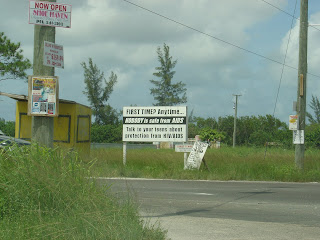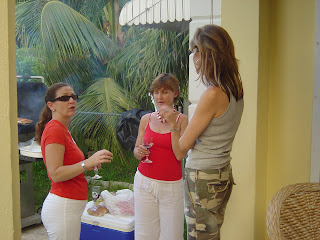




Actually it is mangroves, although I'm not sure there is such a thing as a mango grove, it may be an orchard. I will also apologize now for the length of this post. Sorry.
We took the KidsUp! kids to see some mangroves and learn about Bahamian wetlands. There were several people from an environmental education foundation that came to the kirk to teach about the mangroves before we went to see them. I was reminded how little many of us know about the environment around us. I find it strange to be surrounded by something, for example a forest, and not know what types of plants and animals live there, let alone how that part of the ecosystem works. It's not unlike being surrounded by water, like a Bahamian island, and not knowing how to swim, or maybe even being deathly afraid of it, like a Bahamian. We would all be well served to learn to live within our environment, in an environmentally friendly way.
Anyway, we took the kids to see the mangroves. Many of them, while having seen them before, did not know what they were. They are, according to dictionary.com, any tropical tree or shrub of the genus Rhizophora, the species of which are mostly low trees growing in marshes or tidal shores, noted for their interlacing above-ground adventitious roots. They are found along the southern coast of New Providence island and actually grow in salt water. (If you have not seen one look it up, you will probably find a better picture that what I have provided.) Not knowing what they were, maybe not having heard the word before they went with what they knew, mangoes or mango groves, it all pretty much sounds the same. Thats what we heard all day. . . "Look, its a black mango", or "Hey, a white mango grove". But they really don't look like any normal tree or shrub. They have a tentacle-like root system growing up from the water and down from the branches. Where the growth is moderately thick you cannot walk through.
We learned that there are four kinds of mangroves on New Providence; red, black, white and buttonwood. Each of them are easily identifiable. For instance black mangroves have pneumatophores that extend upward from the root system (like little spikes), which radiates in a star burst pattern from the center of the plant, upwards through the surface of the water allowing them to breath. They act like a snorkels for the plant and looks much like a bed of nails coming out of the water.
We learned about how the mangroves keep beach and tidal area erosion in check. We also learned that developers who build close to the water remove them and are thus stuck with the inevitable erosion of the beach which will eventually cause their buildings to wash into the sea. It has happened in the past, is happening now and will continue to happen. All the developer needs is to get their money out of the property before it becomes a future reef. It is quite sad because government protections are few and rarely enforced. Coincidentally, I just heard on the radio this morning that the new hopeful US ambassador to the Bahamas is a real estate developer from Florida. Isn't that GREAT!?
In any case the kids had a great time. We walked the tidal flats a looked for crabs and sponges, collected shells and the requisite two pounds of sand in our shoes. We also collected trash as we walked. We could go back everyday to collect trash lying around and not complete the job. It was as though a fleet of trash trucks dumped their contents along the road bordering the ocean. Another lesson all by itself. We all learned about environmental dangers to the Bahamian wetlands and what can be done to help.
Things are going well. The kids continue to learn and grow on us, some of them much like a mold; sometimes irritating, often times a little smelly, clingy, colorful and quite beautiful when looked at under a microscope. Their behavior improves each day and they learn alternative methods of solving their problems. Some have a ways to go, but they still want to be there and work so we take that as a positive sign. I am loving my time here with these kids. It really is all about building relationships to make a difference, that will make it all the harder to leave.
Pictures: Identifying Black Mangroves; looking at baby snappers and groupers (fish) in the tidal creek; a butterfly on a White Mangrove; wading in the tidal creek; playing a game in the beach.



















































